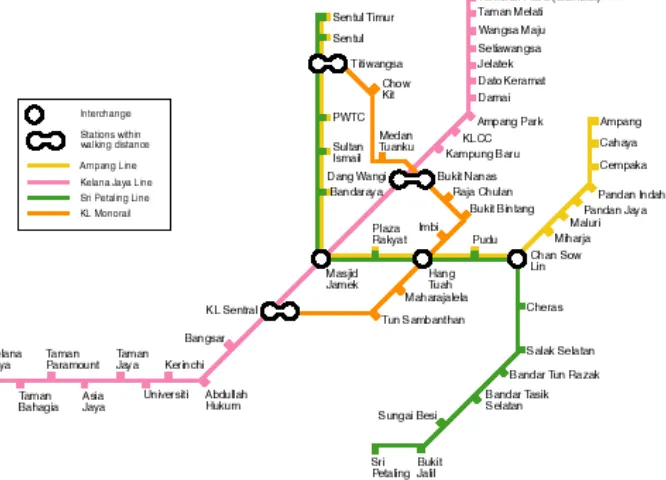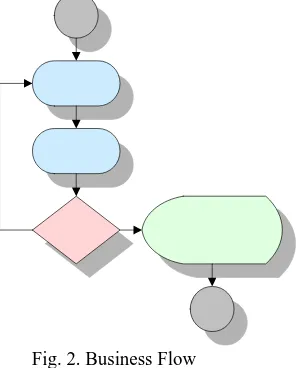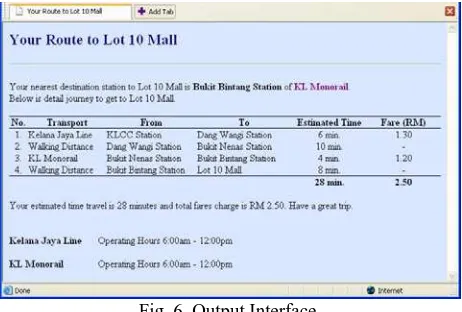Proceedings of the International Conference on I-32 Electrical Engineering and Informatics
Institut Teknologi Bandung, Indonesia June 17-19, 2007
ISBN 978-979-16338-0-2 1098
Destination-Oriented Route in Integrated LRT Web-Based System
for Tourism
S.M. Suhaizan
*, A.A. Azlianor, K. Massila, A.M. Haziq Lim, A. Fauziah
Faculty of Information and Communication Technology, Universiti Teknikal Malaysia Melaka, Locked Bag 1200, Hang Tuah Jaya, 75450 Ayer Keroh, Melaka.
Light Rail Transit (LRT) Monorail and RapidKL are one of the major public transportations in Kuala Lumpur (KL), Malaysia and by traveling in LRT is said to be the most convenient public transport. In LRT RapidKL, there are three train-lines; Kelana Jaya Line, Ampang Line and Sri Petaling Line. This paper addresses the problem of selecting nearest destination station to a given places of interest such as shopping places, historical places and interesting places which may involve at least two LRT lines and need of interchange station. Thus, the traveler may face difficulty when they choosing incorrect station especially on different LRT lines which lead to time consuming and high cost. Producing web-based system for Internet applications in tourism has become wide spread and within this paper, the development of web-based application where destination-oriented routes need to be dynamically generated by determining the nearest station according to the specified places. In addition, this system provides detail information on interchange station (if any), estimated time arrive, total fares and operating hours.
1. Introduction
In this era, Malaysia had developed rapidly and proper infrastructure especially public transportation had already setup to facilitate the citizen to go to certain destination without hassle. Public transport, a major component of the urban transport system, has an important role to play in enhancing urban travel. To meet these challenges, the government has embarked on major developments by privatization projects in land transport especially rail transport by introducing Light Rail Transit (LRT) (1).
Integrated LRT system that consists of three light rail transit lines called Kelana Jaya Line, Ampang Line and Sri Petaling Line. We include Kuala Lumpur Monorail to be part of LRT
system. This LRT system connects some key districts where banks, offices, hotels and shopping malls are concentrated. This LRT system is operated by two different companies. A company called RapidKL manages Kelana Jaya Line, Ampang Line and Sri Petaling Line that comprises of a north-south line and another going eastward. A sole monorail line is operated by KL Monarail Sdn Bhd that looping through the Golden Triangle. Different companies operate the various systems and developed them separately at different times. As a result, making transfer from a system to another
Proceedings of the International Conference on I-32 Electrical Engineering and Informatics
Institut Teknologi Bandung, Indonesia June 17-19, 2007
ISBN 978-979-16338-0-2 1099
escalator-use and even crossing busy roads which may cause waste time and money.
Travelling from one appointment to another in this bustling metropolis can be difficult. Bus transportation is mediocre. And taxi drivers are notorious for haggling over fares. But, thankfully, a light railway system now criss-crosses the city, allowing even harried business travellers to keep their trip on track – away from snarled traffic and car fumes. However, the problem of selecting nearest destination station to a given places of interest (such as shopping places, historical places and interesting places) which may involve at least two LRT lines and need of interchange station, the traveller may face difficulty when they choose incorrect station especially on different LRT lines which lead to time consuming and high cost.
In order to provide information required by public, traveller and tourist, a web-based system as preliminary tool is developed to guide them in gaining visible information they wish to. The user must specify what attraction they wish to visit and their starting station. The system should then provide the following information: the start line to use, interchange stations (to change from line to another), the nearest end station on a particular line, estimated time arrive, total ticket prices, operating hours and train frequency during peak and off-peak hours.
This tool guide benefits the travelers who do not need to learn the routes are those that would find it easy to plan their journey, time and cost. By using this system, the user feels much confidence to be at certain destination they wish to punctually within expected time and these criteria is important and critical for the carrier individual. Indirectly, the government aim to attract society especially Kuala Lumpur citizens to choose public transportation specifically LRT as daily transportation to avoid traffic congestion will became a reality
2. Related Research
There have been many research effort on determine a route base on specified destination place. However, most researches were focused on the road networks whereby they are able to construct dynamic routes to a destination.
With the recent developments of advanced technologies, which include communications, microelectronics, sensors, and information technology, the provision of real-time information on traffic conditions to drivers has become technically possible. Hence, route planning was introduced (4) as one of the functionality of an in-vehicle navigation system. Given a set of origin–destination pairs; there could be many possible routes for a driver. A useful routing system should have the capability to support the driver effectively in deciding on an optimum route to his preference. Another research done is, in navigation systems, a primary function is to find possible routes from the current location (e.g. where a driver is currently positioned) to the destination (e.g. where the driver wants to go) with a minimum expected cost. (6) The cost is referred to expected time of travel from point source to point destination by computing a minimum cost route
satisfying a time constraint.
As mentioned in (3), studies have revealed that route descriptions assist people’s efforts in getting from one place to another. Certainly, we have all experienced assorted forms of navigational assistance, perhaps most commonly verbal driving directions, road maps or strip maps and written lists of turns and landmarks required to negotiate a route. While the usability of various forms of way-finding information may be argued by some, there can be no question navigation assistance is often a critical factor for navigation success.
Mobile users frequently follow the same route to a destination as they did during previous trips to the destination, and the route and destination are important aspects of the context for a range of services. (2) The user’s current location is one possible context and the user’s destination is another. Yet another is the route that takes the user from the current location to the destination. But, how would the situation be if the same route facing road traffic? Thus, problem of selecting route to a given destination on a load map under a dynamic environment has been addressed. (5) When traffic congestion changes during driving, an alternative route can be generated.
This research is focus on LRT systems that can reduce and enhance public transport usage. Problems in the town centre such as growth of private vehicle numbers, increases in travel demand, traffic congestion, centralisation activity and environmental pollution, should be reduced through appropriate integrated planning process between land use and transport planning. (1) The case of travellers to avoid these problems, they face another problem whereby unable to decide on station that nearest to destination place.
Travel is conceptualized as a means of reaching a destination to conduct a particular activity. When making a trip, individuals make observations that may increase their knowledge about their journey environment in reaching their destination. Theory and models were developed (7) to illustrate that expected information gain tends to favor longer trips and variety seeking in terms of both route and destination choice. The results indicated that expected information gain can have an impact on both the location and route component in cases where the individual has limited information about the environment and values information gain positively. The more distant the location or the stronger the deviation from the shortest path, the more information is gained from making the trip.
According to (8), a railway's origin/destination path-selecting behavior with micro-simulation was analyzed in big cities. In big cities, railway networks often consist of lines belonging to several different companies, making railway origin/destination path-selecting behavior very complex. Usually, the second or third nearest stations are used instead of the nearest station in reaching to destination.
3. Destination-Oriented Route
It is important to deliver the right information at the right time with as little user interaction as possible. Therefore, there are only two input criteria determined by a user that are a starting station and a destination place in either shopping complexes, places of interest or hotels. For instance, we want
Proceedings of the International Conference on I-32 Electrical Engineering and Informatics
Institut Teknologi Bandung, Indonesia June 17-19, 2007
ISBN 978-979-16338-0-2 1100
to travel from Kuala Lumpur City Centre (KLCC) to Lot 10 Mall. KLCC is one of the RapidKL Kelana Jaya Line stations and Lot 10 Mall is a shopping complex.
Refer to the example above, the data sent to the web server by the client has two parts; a starting station i.e. KLCC station and a destination place i.e. Lot 10 Mall. When the web server sends data to a client, it will return a route which is a destination-oriented route according to user’s destination place.
Fig. 2. Business Flow
The most important aspect that the route is generated as destination-oriented route is according to data that are fully normalization. We proceed to define the key data structures used for getting a route that end with a nearest destination station to user’s destination place.
The major data that resides in the database consists of LRT stations and destination places where the entity-relationship is one-to-many. Each station has defined the interchange station if there is a possible route consists of more than two lines. We include Chan Sow Lin station operated by RapidKL as interchange station to switch from Ampang Line to Sri Petaling Line and vice versa. Ticket fares and time taken for a LRT train to arrive from the predecessor and successor station are also defined in each LRT station.
Again, for instance, we want to travel from KLCC to Lot 10 Mall. The starting station is KLCC station of Kelana Jaya Line and Lot 10 Mall is the destination place. In generating a destination-oriented route, we concern this information where first we will check that Bukit Bintang station of KL Monorail has defined Lot 10 Mall shopping complex. Next, the system knows that from Kelana Jaya Line, the user need to interchange to KL Monorail station that is Dang Wangi station of Kelana Jaya Line with Bukit Nenas station of KL Monorail. Then, the user will reach to Bukit Bintang station from Bukit Nenas station.
Fig. 3. Process Flow
4. Web-based Travel Guide
The preliminary tool of web-based system is based on 3-tier architecture that is client tier, application tier and data tier. We assume that a client workstation has a web browser such as Internet Explorer and Mozilla Firefox. The web browser only sends information given by a user in HTML format from the web server where business application resides in it.
Fig. 4. Input Interface
The user inputs a starting station and a destination place when this is requested by the client. Then, he receives result consists of a route from stating station and destination station which the nearest to destination place, time estimate to complete, charges of total fares and current operating hours.
Fig. 5. Client-Server Architecture
Proceedings of the International Conference on I-32 Electrical Engineering and Informatics
Institut Teknologi Bandung, Indonesia June 17-19, 2007
ISBN 978-979-16338-0-2 1101
to user’s destination place. All generated destination-oriented route will be saved into the database (in the certain period of time for update purposes) for fast retrieval if the same query is requested by another user. This will reduce server load to process again for the same query which generate the same route.
Since there are only 56 stations in KL LRT system, all queries are successfully processed to obtain the destination-oriented route as long as the data/information is available and up-to-date in the database.
Fig. 6. Output Interface.
5. Conclusion and Future Work
The completion of this research will facilitate the LRT users that are using RapidKL lines and KL Monorail as daily transportation. The system will provide a destination-oriented route from starting station and nearest destination station to destination place, time estimate to complete the journey, charges of total fares and current operating hours. The system is fast and easy to use as it guides user to plan his trip and travel through out the city.
There are several possible directions in which to extend this work. The destination-oriented route will be extended to obtain either shortest route and time, cheapest route or both. For example of shortest route and time, the nearest interchange station is considered to switch lines in order to reach to the destination station which is nearest to user’s destination place. In order to determine the cheapest route, the system will take charges of total fares into account.
References
(1) A’zizan Hussain: A Framework of Light Rail Transit (LRT) in Kuala Lumpur Metropolitan, Malaysia, Proceedings of the 28th Conference of Australian Institutes of Transport Research (CAITR), UK (2006) (2) Agne Brilingaite, Christian S. Jensen and Nora Zokaite: Enabling
Routes as Context in Mobile Services, Proceedings of the 12th annual ACM international workshop on Geographic information systems, Washington DC, USA (2004)
(3) C.M. Chewar and D. Scott McCrickard: Dynamic Route Descriptions: Tradeoffs by Usage Goals and User Characteristics, Proceedings of the 2nd International Symposium on Smart Graphics, p.71-78, Hawthorne, New York (2002)
(4) Grantham K.H. Pang, Kazunori Takahashi, Takayoshi Yokota and Hiroshi Takenaga: Adaptive Route Selection for Dynamic Route Guidance System Based on Fuzzy-Neural Approaches, IEEE Transactions on Vehicular Technology Technology, Vol. 48, No. 6, (1999)
(5) Hitoshi Kanoh and Tomohiro Nakamura: Knowledge Based Genetic Algorithm for Dynamic Route Selection, Proceedings of the Fourth International Conference on Knowledge-Based Intelligent Engineering Systems & Allied Technologies, Brighton, UK (2000)
(6) Sungwon Jung and Sakti Pramanik: An Efficient Path Computation Model for Hierarchically Structured Topographical Road Maps, IEEE Transactions on Knowledge and Data Engineering, Vol. 14, No. 5, (2002)
(7) T.A. Arentze and H.J.P. Timmermans: Information Gain, Novelty Seeking and Travel: A Model of Dynamic Activity-Travel Behaviour Under Conditions of Uncertainty, Transportation Research, Part A, 39(2-3), pp 125-145 (2005)


